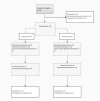Comparing Compensatory Sweating After Video-Assisted Thoracoscopic Sympathectomy: (T2-3) Versus (T2-4) Levels for Treating Palmar Hyperhidrosis
- PMID: 39712769
- PMCID: PMC11661883
- DOI: 10.7759/cureus.74077
Comparing Compensatory Sweating After Video-Assisted Thoracoscopic Sympathectomy: (T2-3) Versus (T2-4) Levels for Treating Palmar Hyperhidrosis
Abstract
Introduction: Primary hyperhidrosis is a disease that is characterized by excessive sweating beyond what is required to maintain the normal temperature of the body. Moreover, it has a great adverse effect on the life of the affected persons because of problems in their social lives. There are different modalities to treat primary hyperhidrosis, including medical and surgical treatment. However, in sympathectomy, there is still a lack of strong evidence regarding which level should be targeted to achieve maximum benefit with fewer complications.
Methods: This prospective clinical study was conducted at the Cardiothoracic Surgery Department, Alexandria Main University Hospital, Alexandria, Egypt, from September 2021 to Jan 2022. The study involved a total of 50 eligible consecutive patients who had bilateral primary palmar hyperhidrosis managed by bilateral, bi-portal, and tubeless thoracoscopic approach with conventional general anesthesia. Group A represents 25 patients with 13 males (52%) who had sympathetic chain cutting at the level of T2-3, and group B represents 25 patients with 15 males (60%) who had sympathetic chain cutting at the level of T2-4. The effect on palmar hyperhidrosis, compensatory hyperhidrosis, and overall patient satisfaction was assessed on the Visual Analog Scale (VAS).
Result: Ninety-eight percent of patients in both groups showed postoperative complete dryness of the hand and improvement of their symptoms. There was a statistically significant (p<0.001) difference regarding the degree of severity of compensatory sweating post-operatively between both groups. In group A, 44% of patients had compensatory sweating, while in group B, 96% of patients had symptoms of compensatory sweating with varying degrees from 1 to 5 on a VAS-Score of five degrees.
Conclusion: The level of cauterization has no significant effect on palmar hyperhidrosis dryness after cutting the sympathetic chain at level (T2-3) vs. (T2-4). However, the greater the number of levels that are cauterized, which are three levels rather than two, the more severe the compensatory sweating in this study.
Keywords: compensatory sweating; hyperhidrosis; sympathectomy; thoracic surgery; video-assisted thoracoscopic surgery (vats).
Copyright © 2024, Guirguis et al.
Conflict of interest statement
Human subjects: Consent for treatment and open access publication was obtained or waived by all participants in this study. Faculty of Medicine, Alexandria University issued approval 00012098. The study has been accepted according to the ethical standards of scientific research. Animal subjects: All authors have confirmed that this study did not involve animal subjects or tissue. Conflicts of interest: In compliance with the ICMJE uniform disclosure form, all authors declare the following: Payment/services info: All authors have declared that no financial support was received from any organization for the submitted work. Financial relationships: All authors have declared that they have no financial relationships at present or within the previous three years with any organizations that might have an interest in the submitted work. Other relationships: All authors have declared that there are no other relationships or activities that could appear to have influenced the submitted work.
Figures
Similar articles
-
[Thoracoscopic sympathectomy for palmar hyperhidrosis. Immediate results and postoperative quality of life].Arch Bronconeumol. 2004 Feb;40(2):67-71. doi: 10.1016/s1579-2129(06)60197-3. Arch Bronconeumol. 2004. PMID: 14746729 Spanish.
-
Plantar hyperhidrosis associated with primary palmar hyperhidrosis: Outcome following video-assisted thoracoscopic sympathectomy.Asian Cardiovasc Thorac Ann. 2021 May;29(4):310-317. doi: 10.1177/0218492321996508. Epub 2021 Feb 20. Asian Cardiovasc Thorac Ann. 2021. PMID: 33611949
-
Thoracoscopic sympathetic clipping for hyperhidrosis: long-term results and reversibility.J Thorac Cardiovasc Surg. 2009 Jun;137(6):1370-6; discussion 1376-7. doi: 10.1016/j.jtcvs.2009.01.008. J Thorac Cardiovasc Surg. 2009. PMID: 19464450
-
Efficacy of Miniuniportal Video-Assisted Thoracoscopic Selective Sympathectomy (Ramicotomy) for the Treatment of Severe Palmar and Axillar Hyperhidrosis.Thorac Cardiovasc Surg. 2019 Aug;67(5):415-419. doi: 10.1055/s-0038-1642030. Epub 2018 May 8. Thorac Cardiovasc Surg. 2019. PMID: 29739022
-
Limited endoscopic thoracic sympathetic block for hyperhidrosis of the upper limb: reduction of compensatory sweating by clipping T4.Surg Endosc. 2004 Jan;18(1):152-6. doi: 10.1007/s00464-002-8940-5. Epub 2003 Nov 21. Surg Endosc. 2004. PMID: 14625754 Review.
Cited by
-
Global research trends and hotspots of hyperhidrosis: a bibliometric analysis (2008-2023).Front Surg. 2025 Apr 22;12:1559951. doi: 10.3389/fsurg.2025.1559951. eCollection 2025. Front Surg. 2025. PMID: 40330089 Free PMC article. Review.
References
-
- Palmar hyperhidrosis: evidence of genetic transmission. Ro KM, Cantor RM, Lange KL, Ahn SS. J Vasc Surg. 2002;35:382–386. - PubMed
-
- Interventions for hyperhidrosis. Dunford L, Clifton AV, Stephenson J, et al. Cochrane Database Syst Rev. 2022;2022:0.
-
- The society of thoracic surgeons expert consensus for the surgical treatment of hyperhidrosis. Cerfolio RJ, De Campos JR, Bryant AS, et al. Ann Thorac Surg. 2011;91:1642–1648. - PubMed
-
- The pattern of the thoracic splanchnic nerves as they pass through the diaphragm. Gest TR, Hildebrandt S. Clin Anat. 2009;22:809–814. - PubMed
-
- Can excessive perspiration contribute to the development of skin tags? A review of the underlying mechanisms and clinical implications. Ogut Ogut, E E. https://doi.org/10.1007/s44337-024-00128-1 Discov Med . 2024;1
LinkOut - more resources
Full Text Sources

